R2AK Time Machine Day 20/25
Published on July 5th, 2020
For five years, the Race to Alaska, a 750-mile course from Port Townsend, Washington to Ketchikan, Alaska, proved that journey trumps destination, and while COVID-19 cancelled the 2020 edition, the Organizing Authority is, for 25 days, sharing their fondest memories from the previous races. Enjoy!
In 2019 Team Backwards AF became the second team to make their way to Ketchikan looking the wrong way throughout the entire event. They like to talk about synchronicity, but we’re all wondering how the hell they didn’t drown or kill themselves between start and finish; typical understated East Coast American.
Actually, I think it’s just veteran adventurers trying to tell a story that can be almost unfathomable to comprehend if you have never known the desperate solitude of overcoming challenges that straddle the thin line between unquenchable victory and demoralizing failure.
READ:
2019 Day 18: Team Backwards AF turns around
Even if you’ve spent time rowing crew in college, training for the bobsled team, or drawing the short straw for your part in the horse costume, you probably still have no idea about the level of metronome synchronicity delivered in nose-to-butt proximity that’s required to take a double rowboat anywhere, let alone Alaska.
In our three minutes of exhaustive search, the only equivalent would be deciding that rather than driving, the best way to get anywhere would be to walk, but 8” behind someone else, and matching their pace—your feet inches behind and following in the wake of theirs. Until you get the hang of it, you’re going to trip a lot.
Once you can hang you’re going to start hating looking at the back of their head, you’re going to resent the nuances of their pace, and you’re going to hate having to look behind you to make sure that you’re not going to run into anything, because in this grasping at straws analogy, you are synchronized walking backwards, backwards AF.
But synchronicity, unyielding backwards tenacity, and 144 energy bars combined as the main ingredients of Team Backwards AF’s success sauce that they slathered all over the finish line yesterday.
They’re the 23rd team to cross the line, the only exclusively human-powered entrant, and in a record that doesn’t even exist, they are the fastest “oars-only” team in the five years of this thing—two days faster than Ian and Janice’s best time as the rowing incarnate of Team Oaracle. (Sorry Janice and Ian.)
Even if you do have experience in collegiate crew/Olympic bobsled/costume horse assery, you probably haven’t done it for as hard, long, and far as Team Backwards AF. Unless you have already rowed to Alaska, it’s hard to fathom the depth of it (Yes, Janice, Ian, we know you have. Please put your hands down there will be time for questions at the end) and even then you might not pick up the nuances of a team that was the essence of simplicity and preparation.
How simple? Their race was the antithesis to the lifting foils, canting keels, and canting masts strategy of the twitchy front running teams whose campaigns were hopped up on complicated whizbang. Their complications started in their boats and continued after we delivered $10,000 on a nail and the internet debated whether fuel cells should be allowed if the moving parts they powered were related to propulsion.
Team Backwards AF dunked on the debate with rim shattering authority by offering the simple, winning formula that strips away all of the complexity, all of the debate, and none of the hard: they rowed. They don’t even have sails, don’t even have a cabin. In another first, Team Backwards AF became the fastest alfresco sleeping team of 2019.
Compared to rowing, sailing is an activity for romantics, gamblers, and opportunists; you never know when the wind will pick up or change direction, and depending on how half full your glass is, the wind might even happen in the right direction. Sailing is somewhere between the R2AK’s running gun offense and Hail Mary pass—one day with the right conditions might take you all the way into the end zone.
Rowing? Pure ground game, smash mouth and grinding it out 3 yards at a time. Rowing without prospect of sail is a double down on an all tortoise strategy with a 3,000+ calories-a-day habit. Zero flash, tons of hard work, zero hope of a longshot winger of a wind line from the heavens—even if they aren’t from the Scarlet Letter era New England, Team Backwards AF’s Maine roots would be our hands-down pick to be on the starting seven for the Puritan League All Star Game.
That last sentence is admittedly 20-100% punchline, but if we could time travel back to the +/- years when they cracked the seal on Thanksgiving, our hunch is that our founding Pilgrims would agree that minus the hats and abundance of buckles, Team Backwards AF is one of them.
Prepared, hard working, steady, wholly without flash despite how impressive it is to make your way to Alaska in a rowboat, earning every mile one stroke at a time as the Puritanical God intended. They didn’t even try the technique of hugging the shore and working the eddies when the main current was against them. They just powered through.
Their campaign was defined by steady from the jump off. From their years of progressively harder voyages in their rowboat taking them from weekend camping trips in the islands off their Maine home, to their plan to row 40-50 miles a day, to actually rowing 40-50 miles a day. “We thought it would take 2-3 weeks.”
Even with the one day they waited for weather before rounding Cape Caution, they hit their goal smack in the middle of those goal posts. 17 days. They had packed 20 days of food, and within minutes of finishing the race, they were talking about getting in their boat tomorrow to go check out some hot springs. They’re race was over, but they weren’t done. Their ferry back south didn’t leave until Thursday. There was so much to see.
Other than a stint in the Coast Guard tending buoys out of Cordova, this was their first trip to Alaska, and while nothing rattled them, they were impressed by the tides, the weather, and the complex waterways. “Every time we thought something was going to be easy…it wouldn’t be. It was hard everyday.”
If the daily difficulty amounted to much more than a deepening of their determination, it certainly didn’t show on their faces or in their daily progress. Even the fact that they haven’t talked to anyone else for 17 days didn’t seem to grind on them. “We’d go for days without seeing another boat, and then we’d see a sail and be like, ‘Oh, there’s Ziska’.”
Other than that and another tree/eagle/whale, they had 17 days of staying in sync, looking at the backs of each other’s heads, and trying to think of anything new to say. Given how tired they were and that they hadn’t been more that 8-10 feet apart for two weeks, the fact that they were still speaking to each other with emotions other than the barbs of cooped up resentment speaks volumes in itself.
The one thing they had wished was that they would have taken more time to train, but busy lives are what they are, and so they treated the first few days of the race as the boot camp in situ for their muscles and calluses to harden themselves. “We’ve rowed together a bunch in this boat, so there’s a lot of muscle memory there.”
After that their life filled into a rhythm:
• Waking up, eating, breaking down their campsite, and stowing it all (1.5 hours)
• Rowing (12-15 hours)
• Setting up camp, eating, going to sleep (1.5 hours)
• Sleep (whatever time was left)
Sleeping ashore every night posed a challenge of finding beaches with at least a tent’s worth of space between the high tide line and the often impenetrable coastal rain forest. “One time we thought we were okay, but we woke up and the water was like 4 inches from our tent.” They moved.
One day they were so tired they decided to tie their boat up in a kelp bed because they read about it the night before and desperately needed a rest. “It’s funny. You’re so tired, you take a five minute snooze and it feels so good.” Break too long, you lose momentum, but 5 minutes? Perfection. “You throw your hat over your face and pass out for five minutes. You wake up feeling like a million bucks.”
Rounding Cape Caution was their roughest day. There were confused seas, maybe a 4-5 foot chop. The boat is fast but sacrifices stability. The reality of rowing in those conditions isn’t like the two person water skimmer of some flat water race; it’s the boat rocking violently, and you try to grab a piece of whatever water you can without jamming your partner’s oar or slamming the handle of the oar into your wrist.
Those can be scary moments, because it’s also the most likely time for a boat to scoop up some water, which increases the weight onboard, which makes it lower in the water, which makes it more likely to do it again. Plus, given the difficulty, your boat is probably doing half the speed it normally does which doubles your exposure time. You can only endure.
Luckily for them, their boat performed perfectly. “The only water we had to bail was when it rained for like 10 hours straight.” Their boat is designed for flat water, but both the team and the designer have been pleasantly and gradually surprised by its offshore ability.
There are teams that finish in Ketchikan with nothing left but their exhausted bodies and a book’s worth of the scariest kind of stories when they had backed themselves into a corner that beyond their limits, the limits of their boat, and they were a hole card away from not coming back. If Team Backwards AF had any whiff of that, we didn’t see it.
They were tired, sure, who wouldn’t be after 750 miles that you earned one stroke at a time? Team Backwards AF had an adventure, but it wasn’t defined by any fate-tempting, nature roulette that we could see. Their adventure was one of accomplishment, consistency, and prudence.
Compared to some of the hairball stories we hear on the finish line, their adventure was one that should be adored; especially by their families, and especially by our insurance broker.
Consistent with their consistency and preparations, Team Backwards AF has not only won the non-existent rowboat division of the R2AK, but they will be joining the ranks of the clever who discovered the cheapest way to get your boat back to the rest of the US. If it’s small enough that you can roll it on yourself, you can bring it to Bellingham on the Alaska State Ferries for $70.
Well conceived, well rowed, and well resolved. Turns out Team Backwards AF has been pretty forward looking the whole time.
WATCH:
Race details – Previous races – Facebook – Instagram
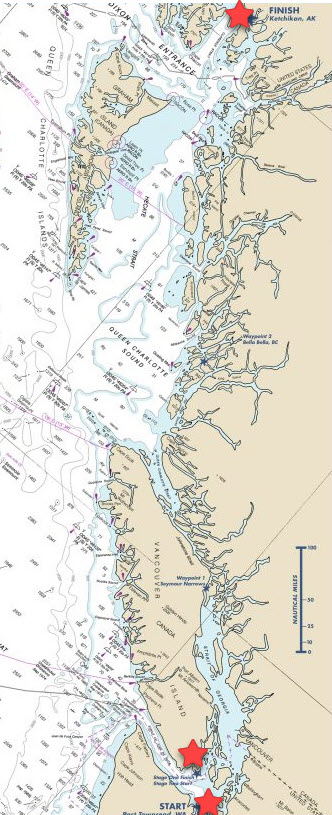 What was to be in 2020:
What was to be in 2020:
Race to Alaska, now in its 6th year, follows the same general rules which launched this madness. No motor, no support, through wild frontier, navigating by sail or peddle/paddle (but at some point both) the 750 cold water miles from Port Townsend, Washington to Ketchikan, Alaska.
To save people from themselves, and possibly fulfill event insurance coverage requirements, the distance is divided into two stages. Anyone that completes the 40-mile crossing from Port Townsend to Victoria, BC can pass Go and proceed. Those that fail Stage 1 go to R2AK Jail. Their race is done. Here is the 2020 plan:
Stage 1 Race start: June 8 – Port Townsend, Washington
Stage 2 Race start: June 11 – Victoria, BC
There is $10,000 if you finish first, a set of steak knives if you’re second. Cathartic elation if you can simply complete the course. R2AK is a self-supported race with no supply drops and no safety net. Any boat without an engine can enter.
In 2019, there were 48 starters for Stage 1 and 37 finishers. Of those finishers, 35 took on Stage 2 of which 10 were tagged as DNF.
Source: Race to Alaska

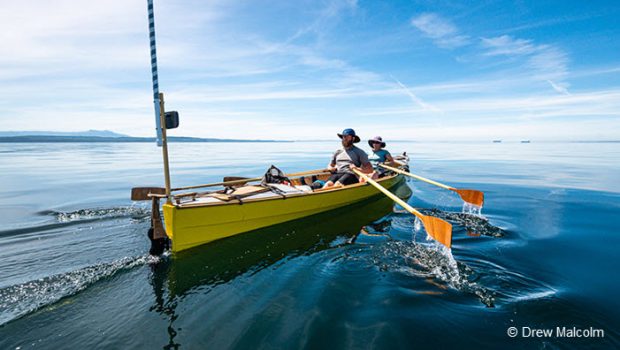


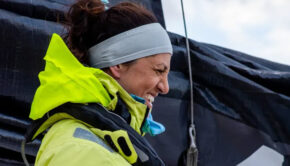
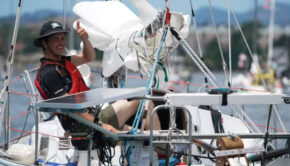
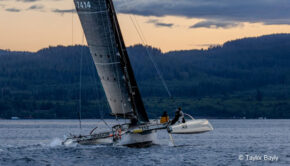
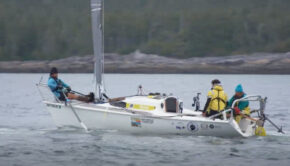
 We’ll keep your information safe.
We’ll keep your information safe.